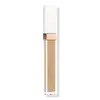Flower Beauty by Drew Light Illusion Full Coverage Concealer Versus Catrice Liquid Camouflage High Coverage Concealer
What's inside
What's inside
 Key Ingredients
Key Ingredients

 Benefits
Benefits

 Concerns
Concerns

 Ingredients Side-by-side
Ingredients Side-by-side

Water
Skin ConditioningDimethicone
EmollientTrimethylsiloxysilicate
EmollientCaprylyl Methicone
Skin ConditioningIsoamyl Laurate
EmollientIsododecane
EmollientButylene Glycol
HumectantGlycerin
HumectantMica
Cosmetic ColorantEthylhexyl Palmitate
EmollientHdi/Trimethylol Hexyllactone Crosspolymer
Silica
AbrasivePEG/PPG-18/18 Dimethicone
EmulsifyingPEG-10 Dimethicone
Skin ConditioningHydrogenated Lecithin
EmulsifyingC10-18 Triglycerides
EmollientSodium Chloride
MaskingQuaternium-90 Bentonite
Aroma
Jojoba Esters
EmollientCaprylyl Glycol
EmollientHelianthus Annuus Seed Wax
Skin ConditioningPhenoxyethanol
PreservativeDimethicone/Vinyl Dimethicone Crosspolymer
Skin ConditioningPotassium Sorbate
PreservativeSodium Dehydroacetate
PreservativePropylene Carbonate
SolventSodium Gluconate
Skin ConditioningHexylene Glycol
EmulsifyingAcacia Decurrens Flower Wax
EmollientPolyglycerin-3
HumectantQuartz
AbrasiveTitanium Dioxide
Cosmetic ColorantIron Oxides
Water, Dimethicone, Trimethylsiloxysilicate, Caprylyl Methicone, Isoamyl Laurate, Isododecane, Butylene Glycol, Glycerin, Mica, Ethylhexyl Palmitate, Hdi/Trimethylol Hexyllactone Crosspolymer, Silica, PEG/PPG-18/18 Dimethicone, PEG-10 Dimethicone, Hydrogenated Lecithin, C10-18 Triglycerides, Sodium Chloride, Quaternium-90 Bentonite, Aroma, Jojoba Esters, Caprylyl Glycol, Helianthus Annuus Seed Wax, Phenoxyethanol, Dimethicone/Vinyl Dimethicone Crosspolymer, Potassium Sorbate, Sodium Dehydroacetate, Propylene Carbonate, Sodium Gluconate, Hexylene Glycol, Acacia Decurrens Flower Wax, Polyglycerin-3, Quartz, Titanium Dioxide, Iron Oxides
Water
Skin ConditioningIsododecane
EmollientCyclopentasiloxane
EmollientPolymethyl Methacrylate
Butylene Glycol
HumectantPolyglyceryl-4 Isostearate
EmulsifyingCetyl PEG/PPG-10/1 Dimethicone
EmulsifyingHexyl Laurate
EmollientPotassium Cetyl Phosphate
EmulsifyingVp/Eicosene Copolymer
Tocopheryl Acetate
AntioxidantTocopherol
AntioxidantSodium Chloride
MaskingPEG/PPG-19/19 Dimethicone
EmulsifyingDisteardimonium Hectorite
StabilisingCera Alba
EmollientDisodium EDTA
Xanthan Gum
EmulsifyingTriethoxycaprylylsilane
Propylene Carbonate
SolventEthylhexylglycerin
Skin ConditioningLecithin
EmollientAscorbyl Palmitate
AntioxidantCitric Acid
BufferingPhenoxyethanol
PreservativeParfum
MaskingCI 77491
Cosmetic ColorantCI 77492
Cosmetic ColorantCI 77499
Cosmetic ColorantCI 77891
Cosmetic ColorantWater, Isododecane, Cyclopentasiloxane, Polymethyl Methacrylate, Butylene Glycol, Polyglyceryl-4 Isostearate, Cetyl PEG/PPG-10/1 Dimethicone, Hexyl Laurate, Potassium Cetyl Phosphate, Vp/Eicosene Copolymer, Tocopheryl Acetate, Tocopherol, Sodium Chloride, PEG/PPG-19/19 Dimethicone, Disteardimonium Hectorite, Cera Alba, Disodium EDTA, Xanthan Gum, Triethoxycaprylylsilane, Propylene Carbonate, Ethylhexylglycerin, Lecithin, Ascorbyl Palmitate, Citric Acid, Phenoxyethanol, Parfum, CI 77491, CI 77492, CI 77499, CI 77891
Ingredients Explained
These ingredients are found in both products.
Ingredients higher up in an ingredient list are typically present in a larger amount.
Butylene Glycol (or BG) is used within cosmetic products for a few different reasons:
Overall, Butylene Glycol is a safe and well-rounded ingredient that works well with other ingredients.
Though this ingredient works well with most skin types, some people with sensitive skin may experience a reaction such as allergic rashes, closed comedones, or itchiness.
Learn more about Butylene GlycolIsododecane is a fragrance, emollient, and solvent.
As an emollient, it helps your skin stay soft and hydrated. Emollients help trap moisture into your skin.
Isododecane's role as a solvent makes it a great texture enhancer. It spreads smoothly on skin and does not leave a sticky feeling behind. Isododecane also helps prevent color transfer in makeup products.
Isododecane is not absorbed into skin.
Learn more about IsododecanePhenoxyethanol is a preservative that has germicide, antimicrobial, and aromatic properties. Studies show that phenoxyethanol can prevent microbial growth. By itself, it has a scent that is similar to that of a rose.
It's often used in formulations along with Caprylyl Glycol to preserve the shelf life of products.
This ingredient is a solvent. It helps dissolve active ingredients and alter the texture of products.
Propylene Carbonate is commonly used in makeup and with clay, such as montmorillonite or bentonite.
Studies show this ingredient to be safe for cosmetics. When it is undiluted, it can cause skin irritation. (It is always diluted in skincare and makeup). This ingredient is water-soluble.
Propylene Carbonate is created from propylene glycol and carbonic acid.
Learn more about Propylene CarbonateChances are, you eat sodium chloride every day. Sodium Chloride is also known as table salt.
This ingredient has many purposes in skincare: thickener, emulsifier, and exfoliator.
You'll most likely find this ingredient in cleansers where it is used to create a gel-like texture. As an emulsifier, it also prevents ingredients from separating.
There is much debate on whether this ingredient is comedogenic. The short answer - comedogenic ratings don't tell the whole story. Learn more about comegodenic ratings here.
The concensus about this ingredient causing acne seems to be divided. Research is needed to understand if this ingredient does cause acne.
Scrubs may use salt as the primary exfoliating ingredient.
Learn more about Sodium ChlorideWater. It's the most common cosmetic ingredient of all. You'll usually see it at the top of ingredient lists, meaning that it makes up the largest part of the product.
So why is it so popular? Water most often acts as a solvent - this means that it helps dissolve other ingredients into the formulation.
You'll also recognize water as that liquid we all need to stay alive. If you see this, drink a glass of water. Stay hydrated!
Learn more about Water